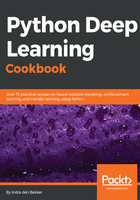
Building a multi-layer neural network
What we've created in the previous recipe is actually the simplest form of an FNN: a neural network where the information flows only in one direction. For our next recipe, we will extend the number of hidden layers from one to multiple layers. Adding additional layers increases the power of a network to learn complex non-linear patterns.

As you can see in Figure 2-7, by adding an additional layer the number of connections (weights), also called trainable parameters, increases exponentially. In the next recipe, we will create a network with two hidden layers to predict wine quality. This is a regression task, so we will be using a linear activation for the output layer. For the hidden layers, we use ReLU activation functions. This recipe uses the Keras framework to implement the feed-forward network.